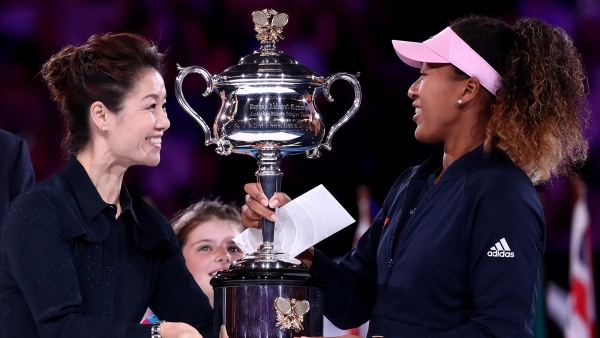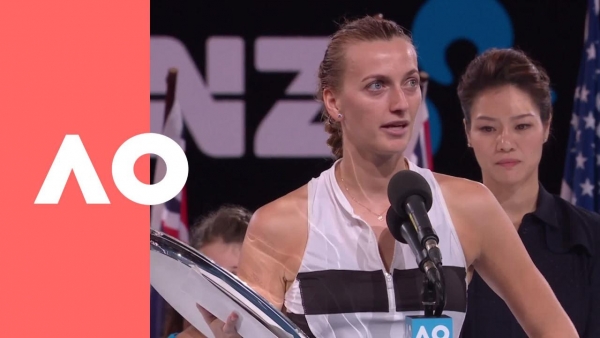1. Dylan Alcott accomplished his mission
Local hero Dylan Alcott achieved his dream on Saturday at Melbourne Park. Not just a record fifth Quad Wheelchair AO title, over rival and No.2 seed David Wagner 6-4 7-6(2), and not just playing for the title at Rod Laver Arena, one of the game’s greatest stages.
Being part of the first live telecast of a wheelchair Grand Slam final, on Channel 9’s mainstream channel, has given the game unprecedented visibility.
MORE: Five things we learned on Day 12
“To broadcast it live to the world, never been done in a final, that’s huge for the movement of parasports, everything that I believe in,” Alcott beamed after his win.
Wheelchair tennis has rolled into the mainstream, and a large part of it is due to Alcott’s towering record and winning personality.
The only time the 28-year-old became emotional in his victory speech was recalling his 14-year-old self looking ahead to a bleak future. The teenage Alcott had no role models in the public eye. “I lay in bed thinking, ‘This sucks. Why don’t I see anybody like me?’ This used to eat me up. Whatever I’m good at, I want to make it.”
Mission accomplished. “This is the definition of making it,” he noted, “broadcasting that to the world.”
Alcott, a Paralympic gold and silver medallist in basketball before winning tennis gold in both singles and doubles at the Rio Games, has packed a great deal into the last 14 years.
Here, Alcott was aka All Over the Place, combining his tennis training and competing (also doubles champion alongside Heath Davidson) with multiple roles – commentating and on-court interviewing for host broadcaster Nine, sponsor appearances for ANZ, disability advocacy and motivational speaking, and promoting his just-released memoir, Able.
“If you put yourself out there, it puts more pressure on you. It really does,” he acknowledged. “I’ve been everywhere the last two weeks.”
The pressure seemed to be closing in when Alcott served for the title at 5-4 and “played horrible.”
“At 5-2 [up] I might have thought I was already in the locker room. I got a bit ahead of myself,” he admitted. In the tiebreak, my box told me to just take a bit more time. I think I won it 7-2. To not choke up and lose meant a lot.”
MORE: Alcott’s high five after wheelchair thriller
Five AO titles for Alcott, lifetime goal ticked, one very happy Australia Day.

2. Li Na, movie star, makes a cameo
Five years on from her women’s singles victory in Melbourne, Chinese trailblazer Li Na was on court to present the trophy to fellow Asian sensation Naomi Osaka – more truth-in-advertising for the Grand Slam of Asia-Pacific.
China’s champion passing the trophy to Japan’s groundbreaking No.1 – who needs the United Nations when you have the global example of Grand Slams?

Li, 37 next month, looks like a movie star – which she is, having just finishing filming her life story. Her hometown of Wuhan in chilly October substituted for Melbourne Park in summery January.
Dominika Cibulkova, Li’s final victim in her 2014 Melbourne win, played herself (no stand-in, what a trooper). The recreated AO final scenes were filmed at night, and Cibulkova didn’t leave the set until 2am. Li stuck around filming her victory scenes with the trophy until 4am.
3. Naomi = No.1
So many firsts were in play for the women’s final between Osaka and Petra Kvitova: a first Australian Open title, first meeting between the two, and the bitter experience of a first Grand Slam title-round defeat for the loser.
The small matter of the No.1 ranking was almost reduced to a subplot.
But with her 7-6(2) 5-7 6-4 victory over a fighting Kvitova for a second-straight Grand Slam title, Osaka is the new No.1 – the first Japanese atop the rankings and the youngest world champion since 20-year-old Caroline Wozniacki in 2010.
MORE: Osaka wins AO title, takes No.1 ranking
Hard to believe the Australian Open is just Osaka’s third pro title – following Indian Wells and the US Open in the last 10 months. A year ago at Melbourne Park, Osaka was No.72.
4. Petra Kvitova is back as a major force
We were always going to feel for the loser of the women’s final between Osaka and Kvitova – two of the most delightful players and personalities in the game.
Probably more so for Kvitova, older at 28 and having endured a violent home invasion little more than two years ago, knife injuries to her left playing hand threatening her career.
Kvitova didn’t drop a set to the final, and showed plenty of heart surviving three match points on her serve in the second set, blasting a couple of forehand winners, sweeping 18 of 22 points and four straight games to force the deciding set.
MORE: Petra sees the bigger picture
But the bold-hitting Czech rued five break chances in the taut first set, especially a 0-40 look at Osaka’s serve in the seventh game.
“I’m not proud at all right now,” Kvitova kidded. “No, definitely I am, for sure. It will be very bad if I’m not. So yeah, it’s hurting a lot today. I wanted to win and have the trophy. But I think I already won two years ago. So for me it’s amazing. I still don’t realise that I played the final. I didn’t know if I [was] going to hold the racquet again. I’m holding it, so that’s good. It’s not the end. Yeah, I be back for sure.”
Sydney winner and runner-up here, Kvitova moves from No.8 to No.2 in the rankings.
“I wanted to be back on my greatest level, probably as I played before,” said the dual Wimbledon champion of her biggest hope when her future in the game looked bleak.
“I knew it will be very, very difficult because my hand, it’s not 100 per cent and never will be. Yeah, I’m feeling great. I’m playing great tennis. I don’t think that I could really imagine [at] the time to be kind of this player again.”
5. Osaka imposes order
Osaka’s back-to-back Grand Slam titles end the run of eight different winners at the last eight majors – unprecedented in the pro era.
The 21-year-old is the first maiden major winner to double up since Jennifer Capriati at Melbourne Park and Roland Garros in 2001.
MORE: Osaka soars to the summit
If the crowd felt for Kvitova, they were thrilled that Osaka could enjoy her winning moment, unlike the aftermath and booing of her US Open win over Serena Williams. “In New York most of the crowd was for Serena, here it felt like they were split,” Osaka observed. “When I was playing her and I heard the crowd was for both of us, I was very happy.”
Also unlike Flushing Meadows, where she romped to the title for the loss of one set, Osaka was taken the distance four times here – by Hsieh Su-Wei (who led 7-5 3-0), Anastasija Sevastova (who won the first set), Karolina Pliskova in the semis and Kvitova in the final.
That she hit and fought her way out of trouble so often is another sign of Osaka’s vaulting progress. Kvitova threatened to rip the match from her grasp in the second set, winning four straight games from match points down at 3-5 to force a final set. Osaka had a mini meltdown, but quickly regrouped after leaving the court before the third set.
“I felt like I didn’t want to have any regrets,” she said of how was able to quickly refocus. “Now I’m just so tired. I still feel very shocked. You’re fighting so hard, when it’s finally over, you’re still in this state of competitiveness.”
The third set was something of a blur. “I felt kind of hollow, like a robot, just executing my orders. I just did what I’ve been practicing my whole life. I didn’t waste any energy reacting too much.”
But Osaka is (thankfully) no robot; endearing and human even as the new No.1. Her only regret came from her dread of public speaking at the trophy ceremony: “I forgot to smile!”

